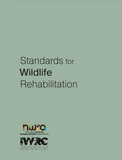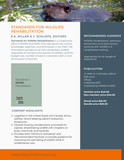Standards for Wildlife Rehabilitation (Available in Ebook or Print)
Standards for Wildlife Rehabilitation e-book—fully reflowable text and graphics with the ability to adjust text size and format.
EBOOKS—READ BEFORE PURCHASING
- Once downloaded, ebooks cannot be refunded or returned
- NWRA Online Store Return Policy
- Ebooks cannot be printed
- Ebooks must be read with an ebook application
- Epub files can be opened on your preferred device with the following applications Adobe Digital Editions (free), iBook, Kobo, NOOK, Sony Reader Touch
- If you cannot locate the downloaded file, check your downloads folder
- We strongly recommend Adobe Digital Editions if you use a PC; not compatible with Microsoft Edge.
Google Chrome is the preferred browser for purchasing Ebooks on Shopify. Once you complete your order, you will be sent to a landing page that will display a message that the file is loading. Wait until a button appears that says “Your download is ready.” Then you will be able to download the .epub file. You will also receive an email with the download link.
Description of Standards for Wildlife Rehabilitation
Standards for Wildlife Rehabilitation (made possible through funding from Partners for Wildlife) is a 2021 publication, based on previous editions of Minimum Standards for Wildlife Rehabilitation, but with so much more!
This book emphasizes that all stages of rehabilitation are undertaken for the welfare of the animal—both while in captivity and after release. Throughout the chapters, call-out boxes highlight how the standards benefit the welfare of the rehabilitating animal, and/or will contribute to the animal’s welfare following release.
This book is a cooperative effort of the National Wildlife Rehabilitators Association (NWRA) and International Wildlife Rehabilitation Council (IWRC) that represents the current knowledge, expertise, and techniques in our field. The information pertains to all who rehabilitate wildlife, regardless of numbers and species of wildlife cared for, budget size, number of paid or volunteer staff, or size and location of activity. Regulatory and species information is specific to the United States and Canada, welfare implications are applicable globally. The intent is not to exclude, but to include and encourage rehabilitators as they strive to improve.
Standards for Wildlife Rehabilitation is intended to improve the well-being of wildlife while in rehabilitative care by providing: a) professional standards and guidelines for appropriate captive care and housing (husbandry); b) recommendations and information regarding wildlife health and welfare; c) guidelines for evaluating wildlife for release, placement, or euthanasia; and d) mechanisms for self-evaluation.
The book itself is divided into three main sections.
▪ Section 1 addresses legalities in the United States and Canada, ethics, welfare, record keeping, patient evaluation, biosecurity, and other general aspects of rehabilitation.
▪ Section 2 addresses general housing considerations and needs for captive, rehabilitating wildlife with chapters on birds, mammals, and herptiles (focusing on species present in the United States and Canada).
▪ Section 3 addresses the final stage of rehabilitation: release conditioning, evaluation, and the final disposition of the animal.
At the conclusion of each chapter are lists of both “Minimum Standards” and “Recommended Practices” for that topic, meant to summarize the points of the chapter and provide further guidance for improving the well-being of wildlife while in rehabilitative care.
Other new features or content include:
▪ Expanded species information, with emphasis on housing needs and enrichment
▪ Expanded chapter on biosecurity
▪ New chapters on disaster preparedness, capture and transport, release preparation, the role of veterinary medicine in rehabilitation, and placement
▪ Expanded sections on disposition, including release preparation, renesting/reuniting criteria and standards, release criteria, surrogacy options, euthanasia criteria, and placement criteria
▪ Expanded Appendices with useful forms
▪ Housing tables separated into English standard units and metric
▪ Photos and colored diagrams help to illustrate concepts and provide examples
▪ A complete Index for easy information access
Standards for Wildlife Rehabilitation is available as an on-line, electronic version (must have internet access and be an active member of NWRA or IWRC to access it). The publication is also available for purchase in print and e-versions.
















